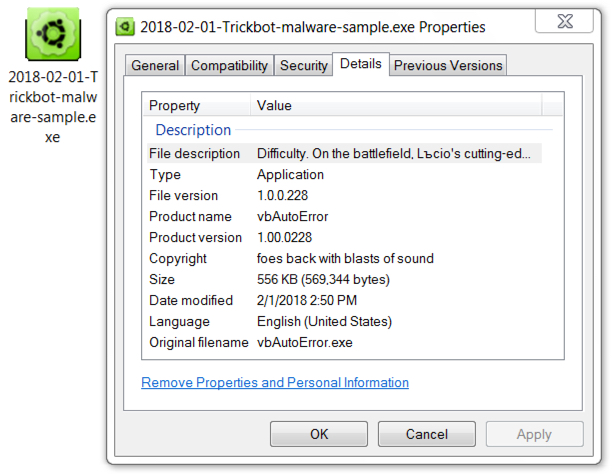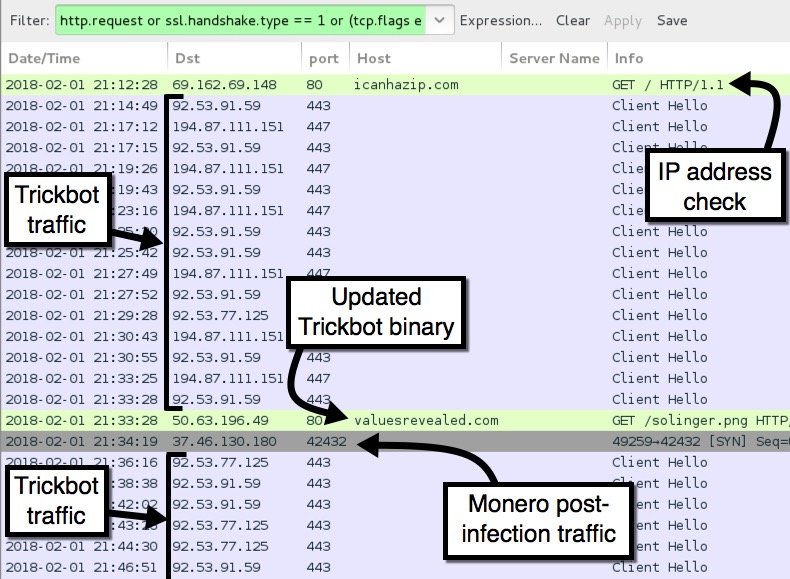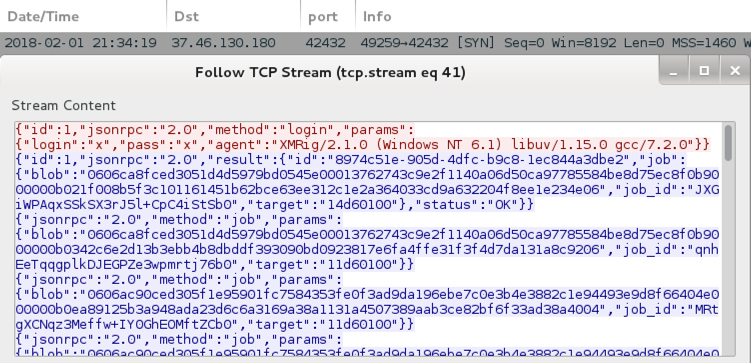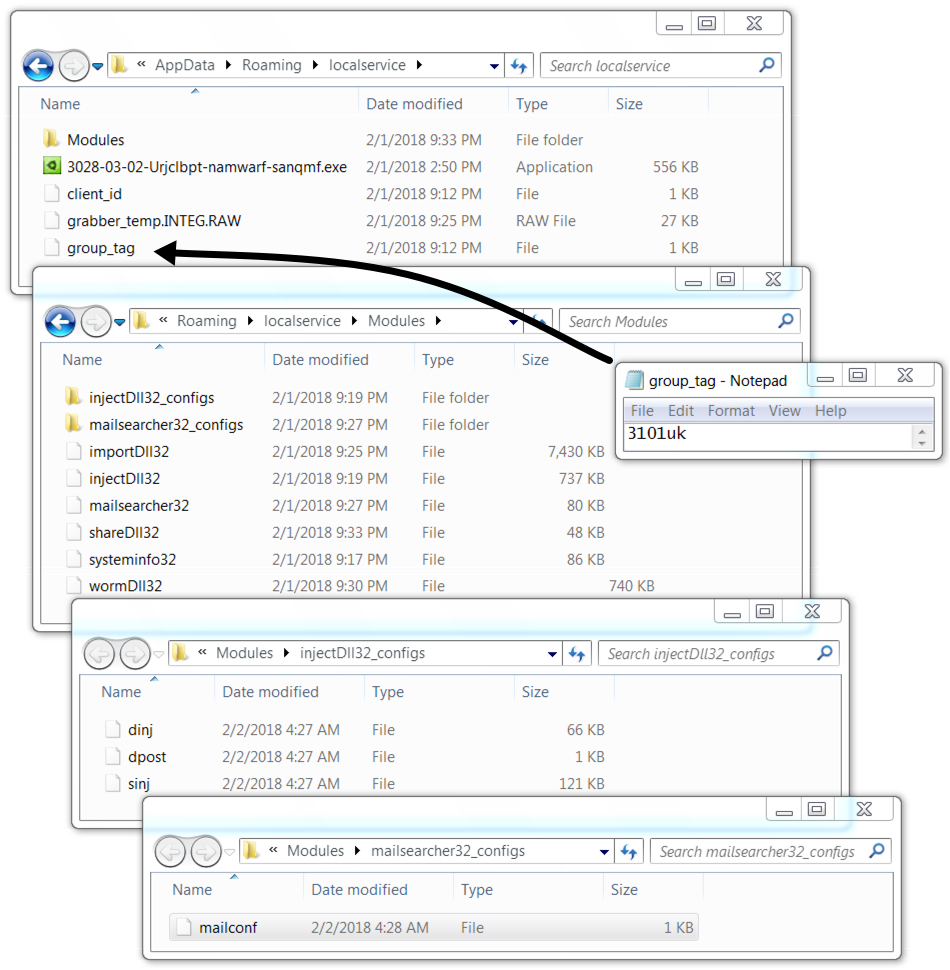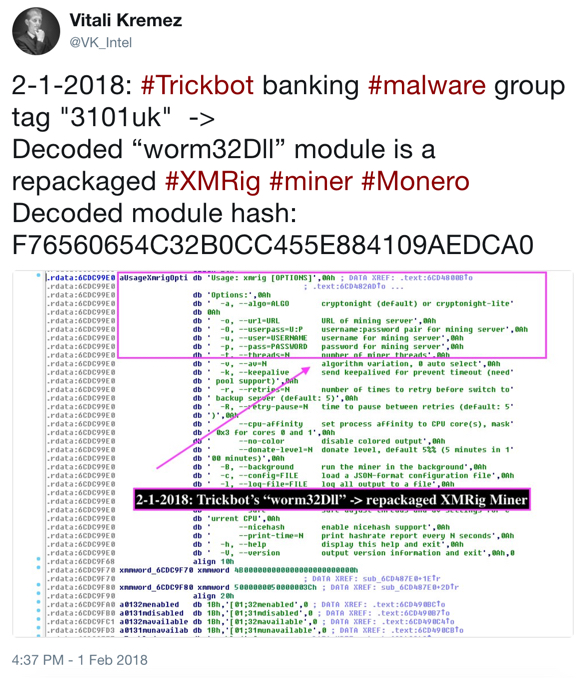2018-02-01 - QUICK TEST DRIVE OF TRICKBOT (IT NOW HAS A MONERO MODULE)
NOTICE:
- The zip archives on this page have been updated, and they now use the new password scheme. For the new password, see the "about" page of this website.
ASSOCIATED FILES:
- Zip archive of the pcaps: 2018-02-01-Trickbot-infection-traffic.pcap.zip 9.5 MB (9,472,261 bytes)
- Zip archive of the malware: 2018-02-01-Trickbot-malware-samples.zip 542.2 kB (542,161 bytes)
INTRODUCTION
I infected a Windows host with the Trickbot malware from 2018-02-01 mentioned in this blog post from My Online Security. I extracted the Trickbot binary located in a pcap from the Any.run analysis of the associated malicious Word document.
The chain of events led from the email to --> link to a Word document --> enable Word document macro --> Smoke Loader --> Trickbot.
Shown above: Trickbot binary extracted from the Any.run pcap.
I wanted to see what the Trickbot binary was doing, since I haven't looked at it in a while. This blog post only reviews traffic and artifacts from a Windows host infected with the Trickbot binary, SHA256 hash 91f78068e996b1b32a3539746b6b683f5fa40e7be009b779c56e215b521df6c5.
TRICKBOT TRAFFIC
Trickbot network traffic in February 2018 is similar to what I saw in this ISC diary I wrote in August 2017. The only difference is a Monero cryptocurrency miner (coin miner) in post-infection traffic in February 2018, which I hadn't noticed before.
Shown above: Trickbot traffic (from the Trickbot binary) on 2018-02-01.
Trickbot SSL traffic is somewhat similar to what we've seen with Dridex SSL traffic in recent weeks. Today's Trickbot traffic triggered Emerging Threats alerts for ET TROJAN ABUSE.CH SSL Blacklist Malicious SSL certificates detected (Dridex CnC), which I've seen with Trickbot traffic before. More importantly, rules from the Snort subscriber's ruleset detected Trickbot SSL certificates, which better fits what I saw on 2018-02-01.
Shown above: Snort alerts on Trickbot certificates in SSL traffic.
Shown above: Emerging Threats alerts on the infection traffic from Sguil using Suricata on Security Onion.
Shown above: Post-infection traffic caused by malware based on Monero (XMRig) coin miner.
FORENSICS ON THE INFECTED WINDOWS HOST
My Trickbot binary was named 2018-02-01-Trickbot-malware-sample.exe, and I ran it from the user's AppData\Local\Temp directory. As we saw with Trickbot back in August 2017, the malware copied itself to a new folder in the user's AppData\Roaming directory. Today's file was re-named, with some (but not all) of the characters in the file name shifted one character. Like we saw back in August 2017, there's a file named group_tag. This time, it contained the text: 3101uk. Below are images showing some of the artifacts.
Shown above: Artifacts on the infected Windows host.
Shown above: Per @VK_Intel, decoded Worm32Dll module is a Monero coin miner (link).
FINAL WORDS
Looks like Trickbot has changed a bit since I last examined it. Traffic and artifacts familiar, but Trickbot has apparently jumped on the cryptocurrency bandwagon by adding a Monero (XMRig) coin mining module. I imagine someone will do a more in-depth write-up on the new Trickbot, but I wanted to get some traffic and malware samples out.
Click here to return to the main page.

